
AI enhances various aspects of television and film production, streamlining processes from scriptwriting to post-production. Machine learning algorithms analyze audience preferences, helping creators tailor content that resonates with viewers, thereby improving engagement. AI-driven tools assist in editing by automating tasks like shot selection and color correction, significantly reducing time and labor costs. Virtual assistants powered by AI can manage schedules, logistics, and communication, allowing filmmakers to focus more on the creative elements of their projects.
AI usage in TV and movie production
Script Analysis and Recommendations
AI can significantly enhance script analysis in TV and movie production by providing data-driven insights that identify trends and audience preferences. For example, tools like ScriptBook analyze scripts to predict box office success based on various parameters such as character development and plot structure. This allows producers at institutions like Warner Bros. to make informed decisions about which projects to greenlight. The potential for improving storytelling and maximizing audience engagement through AI implementation is considerable.
Automated Editing and Post-Production
AI usage in TV and movie production enhances efficiency through automated editing and post-production processes. Tools can analyze scenes for pacing, continuity, and even suggest revisions to improve storytelling. For example, institutions like Warner Bros are exploring AI to streamline their workflows, potentially reducing costs and time. This technology offers the chance to focus more on creative aspects while maintaining high-quality outputs.
Visual Effects Enhancement
AI technology can improve visual effects in TV and movie production by streamlining processes such as rendering and animation. With advanced algorithms, studios like Industrial Light & Magic can generate realistic environments and characters more efficiently. This leads to reduced production times and lower costs, making high-quality visuals accessible to a broader range of filmmakers. The possibility of using AI tools also allows creatives to experiment with innovative storytelling techniques without the constraints of traditional methods.
Audience Engagement and Personalization
AI technologies can enhance audience engagement by offering personalized content recommendations, increasing viewer satisfaction. For instance, streaming platforms like Netflix utilize algorithms to analyze viewing habits, tailoring suggestions to individual preferences. This customization can potentially boost viewer retention and attract new subscribers. The integration of AI in production processes could streamline workflows, allowing creators to focus more on storytelling and less on logistical hurdles.
Virtual Production Environments
AI can significantly enhance efficiencies in TV and movie production by automating tasks such as script analysis and casting decisions. Virtual Production Environments, like those used by ILM for "The Mandalorian," provide the flexibility to create immersive settings in real-time. This synergy allows filmmakers to experiment with various visual styles and narratives with less financial risk. The potential for AI to analyze audience preferences could further tailor content to viewer interests, thereby increasing engagement.
Predictive Analytics for Box Office Success
AI can analyze vast amounts of historical box office data to predict the potential success of upcoming films. By examining factors such as genre trends, casting choices, and audience demographics, AI tools can provide insights that could enhance marketing strategies. For instance, using predictive analytics, a production company like Warner Bros. might determine which elements resonate most with their target audience. This approach offers a chance to optimize investment decisions and reduce financial risks in an increasingly competitive entertainment industry.
Content Localization and Dubbing
AI can enhance efficiency in TV and movie production by automating tasks such as script analysis and shot selection, potentially reducing costs. In content localization, AI tools like language translation software can facilitate quicker and more accurate adaptations of scripts for diverse audiences. Dubbing processes can also benefit from AI-generated voice synthesis, allowing for rapid creation of multilingual versions with high fidelity. These advancements could give production companies like Warner Bros. a competitive edge in reaching global markets.
Digital Imaging and Scene Composition
AI can enhance TV and movie production by streamlining digital imaging processes, enabling faster scene composition. This technology allows for more precise adjustments in visual elements, which can improve overall production quality. For instance, production studios like Warner Bros. can utilize AI to analyze audience preferences, tailoring content to increase viewer engagement. The potential for AI to reduce costs and increase efficiency in these creative endeavors presents significant advantages for filmmakers.
AI-driven Character and Scene Generation
AI-driven character and scene generation can transform the landscape of TV and movie production. This technology allows creators to quickly develop diverse characters and intricate environments, saving both time and resources. For example, a production studio like Warner Bros. could utilize AI tools to enhance storytelling and creativity in their projects. The potential for more dynamic and engaging content increases, offering a competitive advantage in a crowded entertainment market.
Intellectual Property and Copyright Management
AI can streamline TV and movie production by automating script analysis and providing insights into audience preferences. In Intellectual Property (IP) management, AI tools can help track usage of copyrighted materials, ensuring better compliance and royalty calculations. Script generation software, for example, can assist writers in brainstorming ideas and creating content more efficiently. This technology presents the possibility of reducing costs and maximizing creative potential in the entertainment industry.
 techknowy.com
techknowy.com